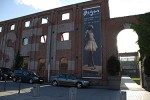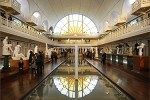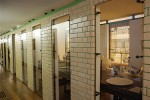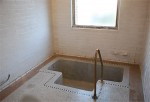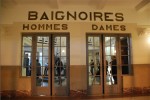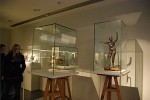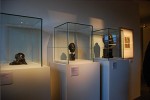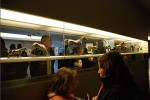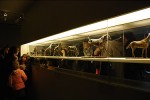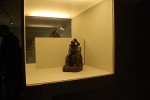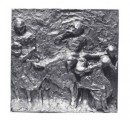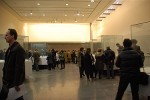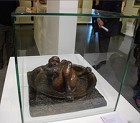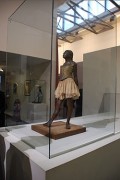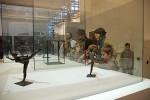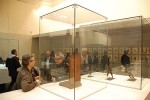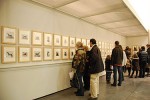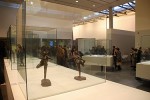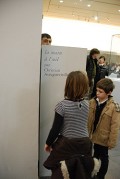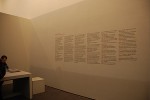The browser will either open the file, download it, or display a dialog.
Degas, Sculpteur (1834–1917): Un exceptionnel Orsay hors les murs
Roubaix, La Piscine, Musée d'Art et d'Industrie André Diligent, Roubaix, France
October 8, 2010 – January 16, 2011
Degas, Sculpteur (1834–1917): Un exceptionnel Orsay hors les murs.
With contributions from Daphné Barbour and Shelley Struman, Catherine Chevillot, Bruno Gaudichon, Richard Kendall, Anne Pingeot, and a reprint of an essay by François Thiébault-Sisson.
Paris: Éditions Gallimard, 2010.
247 pp. with color and B&W illustrations, brief bibliography, and chronology.
39.00 € [Published in French.]
ISBN 978 2 07 013077 1
© Caterina Y. Pierre, 2011.
In the town of Roubaix, which lies about one hundred and thirty-two miles from Paris, one finds a small treasure of a museum. Roubaix—La Piscine is the town's museum of art and industry, housed in what was once the local swimming pool and bathhouse, originally built from 1927 to 1932 (figs. 1 and 2). The renovation of this Art Deco-era space, completed in 2001 by Jean-Paul Philippon (born 1945), is spectacular. Philippon is best known for his conversion of the Orsay railway station into the Musée d’Orsay in Paris, and for his breathtaking ability to preserve, as much as possible, the original spaces and designs of a building. The conservation of the shower stalls and their reuse as exhibition vitrines, the display of the luxurious bathtubs, and preservation of the beautiful pool signage throughout the building act to retain the original glory of the building and make Roubaix—La Piscine even better preserved than the Musée d’Orsay (figs. 3, 4, and 5). The museum's permanent collection, which actually began with a gathering of fabric samples from the local textile production in 1835, today contains an impressive amount of high quality nineteenth- and twentieth-century artworks. Most notable is the collection of nineteenth-century sculpture: the museum holds works by Alfred Boucher, Camille Claudel, Jules Dalou, Alexandre Falguière, Auguste Rodin and many other significant artists, displayed along the edges of the original pool in the central gallery and within the side galleries. Roubaix benefited from a large donation of sculpture from the Musée d’Orsay in 2001, and a relationship continues between the two museums. All of this made Roubaix—La Piscine a perfect venue, this past winter, for an exhibition devoted to the sculpture of Edgar Degas (1834–1917), comprised of a loan of the Musée d’Orsay's collection of Degas bronzes and related works of art.
The Musée d’Orsay's closure of its Impressionist and Post-Impressionist galleries for renovations, which began in 2009 and is scheduled for completion this fall (2011), allowed for the Degas bronzes to make a rare excursion outside of the Orsay to Roubaix—La Piscine, inspiring the exhibition's title "Un exceptionnel Orsay hors les murs" or "An exceptional Orsay outside its walls" (or what was unfortunately translated as "An Outstanding Orsay Roadshow," in the English press release). Curated by Catherine Chevillot and Edouard Papet of the Orsay and Bruno Gaudichon of La Piscine, the exhibition focused on the now-familiar bronze sculptures of horses, dancers and bathers, and related drawings, pastels, prints and photographs, and included over one hundred works. The exhibition text was limited to brief identification labels and a chronology at the end of the presentation. The sections of the exhibition were less like rooms than 'spaces,' and they were not divided up into specific themes; there were simply a few distinct areas, separated only by plexiglas displays, around a large temporary exhibition space. While the lack of text and thematic organization might have troubled those who like to have a bit of context to go with the artworks, audio guides and the open plan gallery allowed for a more free circulation of visitors around the space. The display cases were open on all sides and the plexiglas protected the sculptures from unwanted caresses (figs. 6 through 9).
The exhibition began in a long entranceway with fifteen lithographic prints after Degas's paintings by Georges William Thornley (1857–1935), loaned to the exhibition by the Bibliothèque Nationale de France, Estampes, which set the stage for the artist's key themes. (The space here was quite crowded and dark and could not be properly photographed.) This was followed by some early academic drawings by Degas, an early plaster sculpture entitled L'Écolière (1880–81), and a bronze cast from what must have been a very damaged wax entitled Danseuse s'avançant les bras levés, deuxième étude (see fig. 6, center and right). Dogs Ferreting (1883) by Pierre-Jules Mène (1810–1879) was displayed nearby, as an example, certainly, in the size and subject matter typical to animalier sculptors of the period, of which Mène was amongst the best known. (One of Mène's horse sculptures would have made more sense here, but in any case Mène's work was not included in the exhibition catalogue and his presence in the show seemed to have been an afterthought.) In the same space, three small head studies were displayed, one of a female resting her head in her hands, thought to be a portrait of Rose Caron (1857–1930), a French soprano, and two others of Mathilde Salle (d. 1934), dancer at the Paris Opera at the fin de siècle (fig. 7), so Modernist they would have made Pablo Picasso jealous. Complete with the artist's sculpting tools, this entranceway served as an introduction to Degas the sculptor.
The subsequent space was separated by a long plexiglas case, open on either side, displaying eleven of Degas's horse sculptures (figs. 8 and 9). The lighting was dark in the room, but the case was strongly lit, giving the sculptures within a dramatic display. I found it interesting that the bases of these sculptures were not uniform: sometimes the base was a flat piece of metal and other times the small, hand-pressed nodules of the original wax bases were preserved in the bronze casting. While many of the original wax and plaster sculptures cannot be definitively dated (and all of the bronzes were posthumously cast), the wax horse sculptures seem to have been made in the late 1880s and were inspired by the contemporary motion-study photographs of Eadweard Muybridge and Étienne Jules Marey (both 1830–1904), so influential to many artists at the turn of the century. The bronze horse sculptures here were agreeably arranged in such a way as to give the sense of one horse galloping, and then pausing for rest or water, along the length of the display case.
After this area, the viewer was set adrift. The gallery space continued with additional long plexi cases, one containing sculptures of bathers (fig. 10), another holding related pastels and drawings, and a final case displaying a very unique relief sculpture in Degas's œuvre, Cueillette des Pommes (Apple Pickers, ca. 1865/1881, fig. 11). Abstract to the extreme for a sculpture of the time, there is no apple tree to be seen in this relief and the pickers seem more like a dance troupe, with arms swirling and legs airborne. It is with a sculpture like Apple Pickers, however, that one can grasp at the reasons why, whether he thought so or not, Degas was at the forefront of modern sculpture in the 1880s. In his loose working of materials, his pressing, gauging and scraping of his marks into the now-lost wax, Degas achieved advanced, three-dimensional imagery that Rodin did not display in his works of the early 1880s and that Matisse would not arrive at for some decades.
Once past these works, the darkness of the earlier sections subsides and the exhibition opened out into a large, light-soaked room with free-standing sculptures enclosed in large cases (fig. 12). Noteworthy bronzes included Le Tub (fig. 13) and, without doubt the highlight of the exhibition, Petite danseuse de quatorze ans (Little Dancer Aged Fourteen, fig. 14), shown in close proximity with her nude double (Étude de nu pour la danseuse habillée, see background of fig. 14). It is one of the great ironies in the history of art that this small ballerina, so prized by art lovers and museum visitors today, caused such a scandal when a version of it was shown in the Sixth Impressionist Exhibition in 1881 that Degas never again exhibited another sculpture in public and made no specific plans for the casting of his works after his death. So small and alone in her little glass box, it seems ridiculous that anyone thought to criticize it; but after charges that Little Dancer Aged Fourteen had the head of a criminal and the makings of a voodoo doll, Degas pulled it from the Impressionist exhibition and thus, his future as a professional sculptor, at least during his lifetime, was sealed.
The Musée d’Orsay has almost a complete set of the seventy-three bronzes that Degas heirs decided to have cast between 1918 and 1921; Little Dancer Aged Fourteen was not numbered in the set, but is usually considered number seventy-three. There were approximately one hundred and fifty wax models found in his studio upon his death, but only seventy-three were preserved well enough to be cast into bronze. Each of the seventy-three works were cast in an edition of twenty-two, with one of those sets cast exclusively for the founder Adrien-Aurelin Hébrard (1865–1937) and another cast exclusively for the heirs. Categorized by letter from A through T, the other twenty sets were offered for sale; the Musée d’Orsay owns the set lettered "P." Works from this set were sprinkled around the main gallery at Roubaix (fig. 15).
On the far wall were displayed seventy-two photographs taken by a photographer named Gauthier in 1918 after the discovery of the sculptures, marking the first time that all of the photographs in the series were shown together (figs. 16 and 17). While the photographs are documentary in nature, that is, they are not particularly artistic, they serve as a living record of the sculptures that were set to be cast by Hébrard. Visitors in Roubaix took the time to look at the neatly arranged double row of black and white photographs of wax sculptures that corresponded to almost all of the bronzes behind them in the exhibition.
It should be mentioned that many children were among the viewers on the Sunday that I visited the exhibition. They seemed to enjoy it immensely, in part because the sculptures are small and wonderfully dynamic, like little toys. The problem, of course, is that all children want to touch toys, and these sculptures were safely kept from their grasp in big plexi boxes (fig. 18). To alleviate the strong, haptic tension that must have beleaguered the smallest of art lovers, an additional project was included within the exhibition (fig. 19). Spread around the galleries were a few mysterious boxes into which one could put their hands (or if one was small enough, one's head or nose) and feel different objects and textures. These boxes were created by Christian Astuguevieille (b. 1947), best known for his fashion and furniture designs. In the English press release, these were explained as "a real laboratory for meditating on sculpture which is becoming one of the major areas for the [sic] La Piscine scientific and cultural project."[1] At first I scoffed at the intrusion of these boxes that seemed to have little to do with the exhibition itself; but the children were having such a good time exploring the Astuguevieille project that I willingly gave over to it and realized that it served a good purpose. The exhibition ended with a catalogue reading room and wall text listing a chronology for Degas (fig. 20).
While Degas Sculpteur did not travel beyond Roubaix, the presentation of these sculptures followed a somewhat "competing" exhibition of recently discovered and recently cast bronze sculptures, cast after what is thought to be a set of "lifetime plasters" made by Degas; these are known unofficially as the Valsuani bronzes. [2] The plasters are owned by the Degas Sculpture Project Limited of New York. An additional set of seventy-four plasters were found between 2001 and 2004 in a storeroom at the Valsuani Foundry in Chevreuse, France, and were sold to Walter Maibaum, art dealer and director of Modernism Fine Arts in New York and the Degas Sculpture Project Limited. The Valsuani bronzes were exhibited in the spring and summer of 2010 at the Herakleidon Museum in Athens and the Tel Aviv Museum of Art, and are scheduled to be exhibited at the New Orleans Museum of Art in November of 2011. For reasons of personal and professional liability, no Degas scholars have gone on record with an opinion of these newly discovered works, and the recently published Edgar Degas Sculpture, a catalogue raisonné just published by the National Gallery of Art, Washington, does not include them.[3] The Degas Sculpture Project Ltd. website promises an "international symposium in which all the experts and scholars will be able to present their opinions about the plasters in an open forum."[4] While such a symposium should be welcomed by scholars, it has the potential of turning into un dîner de cons; all of the Degas bronzes, including the Hébrard casts, are posthumous, and archival records for all of the plasters and waxes are sketchy at best. Degas practically forbade anyone from speaking about his sculptures after his death and was claimed to have said that "My sculptures will never give that impression of completion that is the ultimate goal of the statue-maker's trade, and since, after all, no one will ever see these efforts, no one should think of speaking about them […]. After my death all that will fall apart by itself, and that will be better for my reputation."[5] Thus, these current events, and the scholarly publications that have very recently emerged from them, remind us that all Degas's bronzes that we look at are merely simulacra of, and have many degrees of separation from, the artist's original materials and intent.
Degas Sculpteur was accompanied by an exhibition catalogue in French of the same name and included six essays along with an illustrated section of the exhibited works. An introductory essay by Bruno Gaudichon covers the history of the Hébrard casting, a chronology of the sculptures, and Degas's influence on later artists. Anne Pingeot presents a brief but excellent discussion entitled "Quand les peintres sculptent," ("When Painters Sculpt"), covering the usual suspects including Gustave Courbet, Gustave Doré, Jean-Léon Gérôme, Honoré Daumier, and Paul Gauguin. Catherine Chevillot writes an essay on Impressionist sculpture dealing with the works of Degas, Rodin, and Medardo Rosso (1858–1928). Little Dancer Aged Fourteen is given her own essay, contributed to the catalogue by Richard Kendall, and Daphne Barbour and Shelley Sturman, who were also authors of the Edgar Degas Sculpture catalogue raisonné, offer a technical discussion with very good diagrams of the plaster casting and lost wax casting methods and analyses of the chemical compositions of the bronzes, patinas, and bronze thicknesses. Finally, the catalogue includes a complete reprint of François Thiébault-Sisson's 1921 essay "Degas sculpteur raconté par lui-même." While most of the essays are short and the illustrated section of exhibited works does not include any catalogue-type entries, overall this text was an excellent companion to the Roubaix exhibition and is essential for anyone interested in the subject of Degas and sculpture. Although the sculptures exhibited in Roubaix were old news, the research of the catalogue did much to refresh them.
It is certain that we have not heard the last word on Degas's sculpture and I expect the art world will be bombarded, for better or worse, with continued exhibitions of both the Hébrard and Valsuani bronzes for many years to come. But if we accept the bronzes for what they are, that is, the ghosts of what might have been if Degas had considered himself a sculptor and had pushed himself further in that direction of study, much can be gained, not only towards a better understanding of the artist, but also of the rich, complicated history of nineteenth-century sculpture. Leading us in this direction was what was attempted, and accomplished, within the luxuriant jewelry box that is Roubaix—La Piscine.
Caterina Y. Pierre, Ph.D.
caterinapierre[at]yahoo.com or caterina.pierre[at]kbcc.cuny.edu
Links:
Atelier Jean-Paul Philippon
http://www.philippon-architecte.fr/index.php
Joconde – Catalogue des Collections des Musées de France
http://www.culture.gouv.fr/documentation/joconde/fr/pres.htm
Musée d’Orsay, Paris
http://www.musee-orsay.fr/en/home.html
Roubaix, La Piscine, Musée d'Art et d'Industrie André Diligent
http://www.roubaix-lapiscine.com/
I wish to express my gratitude to Roubaix—La Piscine, Musée d'Art et d'Industrie André Diligent, which allowed me to photograph the exhibition. My research travel to Europe in 2011 was made possible through a PSC-CUNY Faculty Research Award.
[1] The English press release can be found as a pdf file at:
http://www.ville-roubaix.fr/FCKeditorFiles/File/PDF/Degas_sculptor.pdf
[2] Much of the information about the Valsuani bronzes to date has been reported in art historical trade journals. See Martin Bailey, "The Silence of the Degas scholars," The Art Newspaper 211 (March 2010), retrievable online at http://www.theartnewspaper.com/articles/The-silence-of-the-Degas-scholars%20/20306; William D. Cohan, "A Controversy over Degas," ARTnews (April 2010), retrievable online at http://www.artnews.com/issues/article.asp?art_id=2855; Patricia Failing, "The Mysteries of Degas's Sculpture," ARTnews (May 2011): 100-107; and Judd Tulley, "Cast in Doubt – Again," Art + Auction (April 1, 2010), retrievable online at http://www.artinfo.com/news/story/34194/cast-in-doubt-again/.
[3] Suzanne Golver Lindsay, Daphne S. Barbour and Shelley G. Sturman, Edgar Degas Sculpture (Washington, DC: National Gallery of Art, 2010).
[4]http://degassculptureproject.com/
[5] Daphné Barbour and Shelley Struman, Catherine Chevillot, Bruno Gaudichon, Richard Kendall, and Anne Pingeot, Degas Sculpteur, exh. cat. (Paris: Gallimard, 2010). The recollections of Francois Thiébault-Sisson, originally published as "Degas sculpteur raconté par lui-même," in Le Temps on 23 May 1921, was reprinted in the Roubaix exhibition catalogue, pp. 85-87. "Jamais mes sculptures ne donneront cette impression d'achevé qui est le fin du fin dans le métier de statuaire, et, comme, après tout, on ne verra jamais ces essais, nul ne s'avisera d'en parler, pas même vous. D'ici ma mort, tout cela sera détruit de soi-même, et cela vaudrait mieux pour ma réputation." The English translation for this excerpt can be found in Roger J. Crum, "Degas Bronzes?" Art Journal 54:1 (Spring 1995): 93-98.


